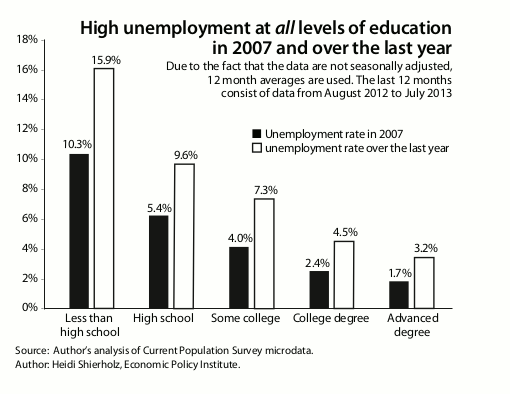



The figures in the study confirm that the bosses’ need for labor power at all skill levels and in all occupations drastically declined between 2007 and the year ending July 2013. This is further confirmation of Marx’s general law of capitalist accumulation discussed in our last column.
Shierholz was rightly trying to refute the widespread campaign by the publicists for the bosses about how unemployment is caused by a “skills mismatch” — workers not having the right skills or enough skills to get all those jobs out there that are going begging.
The study, “Is There Really a Shortage of Skilled Workers?” thoroughly refutes the “skills shortage” argument. (epi.org, Jan. 23)


It is important to note here that the higher the skill level the higher the change in the rate of unemployment. That makes sense in capitalist terms because the higher the skill level, the greater the wages and salaries. Getting rid of the higher-paid workers brings a bigger payoff for the bosses per job eliminated.
Unemployment up, job openings down in all occupations
To drive home the point of an excess of workers — the reserve army of unemployed — being forced to compete for a diminishing number of jobs, the study shows that the number of workers seeking jobs vastly outnumbers the job openings in all occupations in 2013 (see graph).
For example, in the retail trade there were close to 1.4 million workers and less than 400,000 job openings. In accommodation and food services 1.2 million workers were competing for fewer than 400,000 job openings. In manufacturing 625,000 workers are looking for a job but there are fewer than 100,000 manufacturing job openings. Similar gaps exist in all occupations.
Shierholz also shows that in 2012 the average number of hours worked per week in each occupation has declined in almost all occupations compared to 2007. This demonstrates clearly that the unemployment numbers have nothing to do with bosses adding hours to the present shifts.
The study shows that the sure sign of any tightness in the labor market in any particular occupation would be an increase in wages. Shierholz shows that, on the contrary, in occupation after occupation wages have fallen in 2012 compared with 2007.
In compiling these figures, the Economic Policy Institute makes the argument for more investment by the capitalist government in job stimulus. And it is a progressive argument. The working class, community and student organizations should demand a widespread jobs program. Anything that will alleviate unemployment and the suffering and hardship of the workers and the oppressed should be supported.
However, no temporary stimulus package will get around the present crisis of capitalism. Science and technology have been used by the bosses to get rid of millions of jobs permanently. Technology has also been used to reduce the skills required for the remaining jobs and lower wages. Massive investments in robots, computers and automation of all types, are part of capitalist competition among the giant monopolies to raise their profits, to get greater market share and, in the course of this process, for each capitalist outfit to reduce their wage bill. As Karl Marx explained, 150 years ago, that is why they spend the money on technology.
Fred Goldstein is the author of “Low-Wage Capitalism” and “Capitalism at a Dead End,” which has been translated into Spanish as “El capitalismo en un callejón sin salida.” See lowwagecapitalism.com. Both books available at online booksellers.
As part of Workers World newspaper’s coverage marking the 50th anniversary of the liberation of…
From the PFLP Central Media Office The following statement from the Popular Front for the…
Newark, New Jersey Over 250 people, representing over 250 New Jersey endorsing community groups, attended…
Special to Workers World The following is a press release issued on April 24, 2025,…
dear Larry Krasner, we heard you sued Elon Musk over his corrupt million election giveaways…
Unions join forces against harassment and deportation of members When 200 immigrant workers – from…